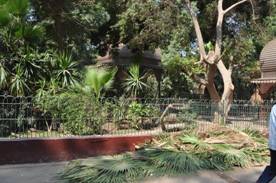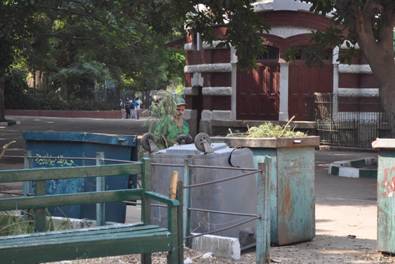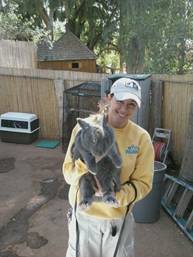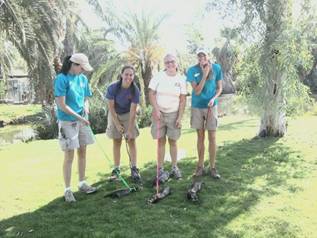|
Alexandria
Chimpanzee Integration.doc
GENERAL SUGGESTIONS
Substrate. Due to the fact that most of the animals are
kept on hard, unyielding surface (concrete, tile, wood
floor, etc.), introducing substrate to all cages is
an appropriate first step. It is a challenge to provide
substrate because people smoke a lot and throw the cigarette
butts into the cages creating a potential fire hazard. The
use of appropriate substrate (inside- paper products
and hay or straw, etc.; outside- nonflammable materials such
as sand, soil, mulch, fresh browse, etc.) will make a
significant difference not only in the animals’ health but
would improve the aesthetics of the exhibits. The substrate
presentation is available both in English and Arabic for all
zoos’ convenience.
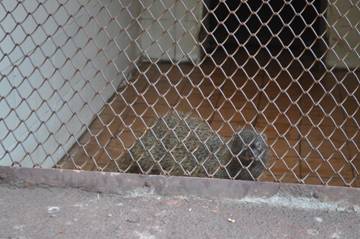
Browse. All zoos have large amount of edible vegetation
available on grounds that could provide fresh, leafy
branches (browse) at least every 2-3 days but if possible,
every day. As mentioned during the presentations, all zoos
can start planting edible trees, bushes and even crops
inside and outside of exhibits, along visitor pathways and resting
areas that will provide future browsing materials for growing
collection demands. Whether cut by staff or available
by natural damage, fallen vegetation can be used rather than
wasted. The browse presentation is available both in
English and Arabic for all zoos’ convenience.
A list of edible plants, toxic plants by common and
scientific names, tree pruning instructions as well as the
Phoenix Zoo’s browse schedule is attached for your convenience.
3 dimensions to increase
space. In most of the exhibits/displays,
animals can only use floor space. Exhibits should
utilize three dimensions by adding large tree trunks, ropes,
fire hose, hammocks, wooden shelves, etc.,
to increase space and to the animals’ opportunities
for exercise and exploration. Furniture needs to be built from
wood, ropes or any kind of natural materials as opposed
to metal. Metal is cold in the winter and hot in the
summer, making it uncomfortable to the animals and
potentially creating medical problems.
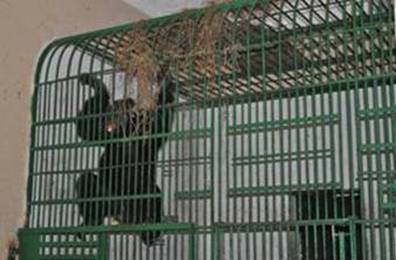
Extending foraging time. All animals (especially in
small, unnatural environments) need to be fed in a way that
their foraging time is extended and proper species-specific
behaviors are encouraged. The Contra freeloading presentation
is available both in English and Arabic for all zoos’
convenience.
Appropriate social housing. All animals that are
social by nature should be paired up with their conspecifics.
Special attention needs to be paid to social housing
of great apes and other primates. Please see attached
document regarding laws and regulations for social housing
of primates. Animals of social species especially primates, lions
cubs, etc., should not be bred, taken away from their mothers
under age and/or kept isolated for picture taking. If
animals are confiscated, they should be immediately
introduced into social groups and an effort to return these
animals to their original country should be attempted.
Physical abuse of animals
as well as chaining or tethering for picture taking should
stop immediately. It is a serious problem, because this is
extra income for the keepers (directly going into their pockets)
as well as for the photographer whom the zoos have a
contract with. It was suggested that instead of taking
pictures with animals, keepers could allow visitors to go
inside empty night houses, permit their children to feel and
act as if they were animals, while taking pictures of the
children for tips.
There are some species that handle picture
taking and human handling better than large mammals. Examples
include small lizards, rabbits, snakes, domestic ferrets,
and some birds.
Flemish rabbit and
domestic ferrets walking around the zoo and interacting with
visitors for picture taking and education purposes.
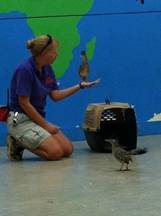 |
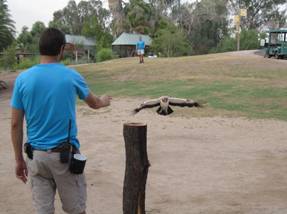 |
Roadrunners interacting
with visitors in the education building and visitors can observe
the king vulture flying in the open areas and learn about animals
behavior at the same time.
The zoo or the GOVS needs to re-evaluate the salary of
the staff. It is my understanding that the people rely on the
picture taking method due to the fact that they could not
sustain their every day living lacking it. Without providing
a bit more money, it will be almost impossible to stop the
picture taking and the related animal abuse (chaining,
roping, forcing animals to stand at one place for hours at
the time, etc.) and exploitation. The keepers will go behind the
management’s back and will try
everything to receive the extra income.
All zoos need monetary aid for exhibit renovations.
Accounting for the zoos' financies, it might be necessary to
increase the entry fee once again? Once the old exhibits are
renovated, the zoos could expand their collections,
but first , all old exhibits should be brought up to
standards. Please review
Association of Zoos & Aquariums (AZA) accreditation
standards and South African National Standards and the Professional
Code of Ethics of the African Association of Zoos and Aquaria.
All animals need to have access to drinking water 24 hours a
day from automatic waterers and proper furniture. Please
review information regarding Lixit Automatic Dog
Waterer for Outdoor Faucets & Spigots
Gun
Dog Supply
Creating picnic areas
for the visitors could provide a better experience for
visitors; they would not have to sit on the floor or on the
curbs and fences .
Picking up garbage during the day time should be
incorporated into the staff's daily routine.
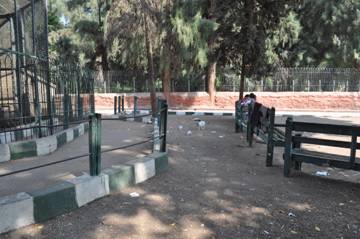
The zoos should change their smoking policies. The first
step could be creating designated smoking areas (tables,
chairs, ashtrays, garbage cans) for the visitors and direct
them to these areas to smoke. Keepers should not smoke
anymore in front of the visitors at all, and absolutely should not
smoke inside the animals' night houses and/or next to the
animals. Keepers need to have designated smoking areas
as well but behind the scenes, out of the visitors’ view
and should only smoke during their breaks.
The keepers’ workload
needs to be expanded. I have observed many keepers
sitting on camping chairs and smoking for long period of
times. Instead, they could start rebuilding the empty cages,
putting the right furniture into them, cut browse, plant
gardens (corn, banana and other usable plants), provide
enrichment, train their animals for basic medical and
husbandry behaviors, plant edible trees inside/outside the
exhibits for future use and shade, plant grass, paint the
walls of exhibits and night houses, clean the zoo daily and
monitor the visitors' behaviors by telling them not to throw
away garbage, cigarette buts, etc. They should answer the
visitors' questions, talking about their animals' ages,
names, behaviors, etc. so the visitors would start learning about
them.
Keepers also can do scheduled keeper talks;
for example, at the 10:00AM elephant feeding, keepers
could speak to visitors about the elephants. There can be
signs posted in front of the exhibits and at the front gate
advertising the scheduled events.
DNA testing chimpanzees. In all the zoos, the
chimpanzees will need to be DNA tested and put on birth
control, or if they need to be bred, grouped by proper
subspecies.
General suggestions for elephant care:
One meter deep sand needs to be added both
inside the night house and onto exhibit. Elephants cannot be
kept on the concrete. It is very hard on their feet and
joints and causes severe medical problems.
Besides sand covering the floor, the elephants need a larger
pile of sand (2 meter high) for them to lie down
upon.
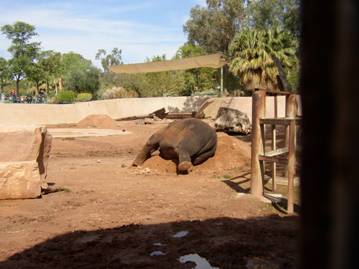
The animals need to be fed continuously from feeder devices
(metal kegs with holes food inside, hay bags, etc.) and
mostly from up high. Hay bags can be woven from ropes. The
nets from international cordage are made specifically for
elephants; the zoos would have to contact the company for all
the details about rope, size, etc. The Phoenix Zoo
was the first zoo to have them so ours nets were prototypes.
http://www.international-cordage.net/
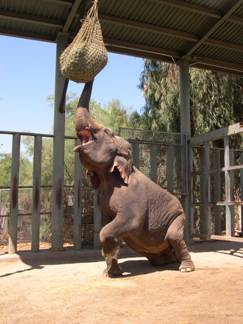
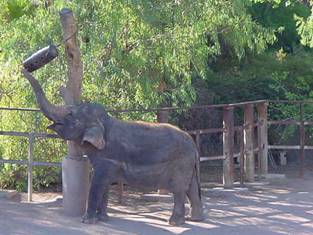
Elephants need to receive large EDIBLE tree
branches every day (please
see attached browse list for elephants).
The animals should not be chained anymore
and picture taking should be discontinued or at least
reduced.
Tires can be hung from chains as enrichment.
Scratching posts made form
palm trees can be chained or secured in any safe way onto
the fence or the poles.
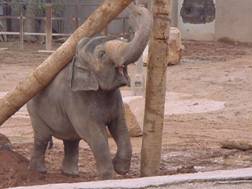
Large tree logs (whole trees) can be laid
all over the ground to encourage the animal to step
over and around them,
providing exercise.

Clay wallow
can help with proper skin care and prevent
sunburn
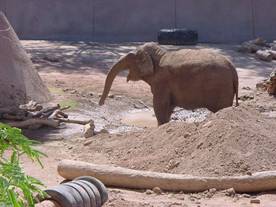
Toys such a large planet balls are available at
http://boomerball.com/
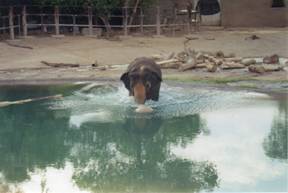
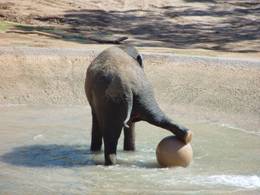
The elephant presentation is available
both in English and Arabic for all zoos’ convenience
SPECIFIIC SUGGESTIONS BY ZOOS
GIZA ZOO
Elephants
0.2 Asian and African elephants. During the 5
elephant presentations all the above mentioned general
suggestions were addressed. One of the elephants had some
skin care problems on her head.
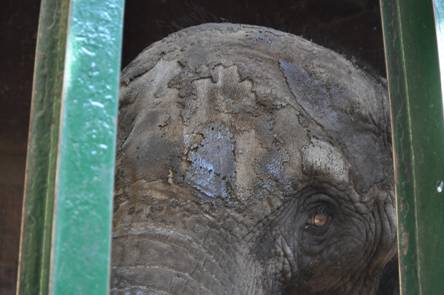
For further suggestions
regarding basic foot and skin care, management should
contact Heather Wright, Elephant Manager of Phoenix Zoo at hwright@thephxzoo.com.
As it was agreed, 1 meter of
sand needs
to be placed both
inside and outside of both
the Asian and
African elephant holding areas. Engineering
consultant Dr. Salah Zaki, President of Gardens and
Treasures Society, who has been done many drawings and
analysis requests free of charge to the zoo is willing to find
solutions to make sure the doorway will not be blocked with
sand in the enclosures.
It was also suggested to build a metal pole chute leading
to one of the nearby exhibits (only few meters away) that has
lake water so the elephants could go and swim.
Signage for Rescue
Center. The Giza Zoo should start providing proper signage
by the chimpanzee exhibit explaining
to visitors that it is the only recognized rescue facility
and that is th e reason why some of the animals look
unhealthy. In my understanding the Egyptian people have a
low tolerance for animals that look different (dwarf, sick,
physically disabled, etc.). There is a notion that all
sicknesses are transmittable to humans, and therefore, these
animals should be locked away far from human sight and
contact. Visitors would also criticize the zoo for
mismanagement. Improved education would help
visitors understand that Giza Zoo did not cause the unfortunate
situations of these animals. On the contrary, the zoo has rescued
them and are trying to help these animals. Moza chimpanzee’s
tumor problem or Kuku’s unusually short limbs could be the
first examples.
Chimpanzees
Moza and Kuku chimpanzees should remain at the
chimpanzee building so they can
have visual and auditory contact with the larger group.
Explaining their situation would be the first step towards a
long education process of what is a rescue center means.
The 3 babies should be kept together
with their surrogate parents at all times, except
for feeding times IF AND ONLY IF there is a problem with
feeding. Bobo needs to get used to being in a social group.
Otherwise, keepers can try to feed them together, offering
food always first to the dominant animal, making him/her
relaxed and then see if the subordinate animals could be fed as
well. If not, then in the morning, the animals can be given
a large breakfast before being put together. Outside the
food should always be chopped into small pieces and
scattered. At night, the chimpanzees can be separated again
;for feeding. But, in any case, the keepers need to
encourage the animals to eat together peacefully and try not
to separate them at all. The animals should be locked inside only
during the wintertime. All animals should have access
outside at night to only be asked inside in the mornings for
a short period of time so they do not loose the routine of
coming inside when asked. If the animals show signs that
they do not wish to be separated (holding the doors with
their foot, hand or hug each other and move away from the door),
then the keepers should not separate them. However, in the mornings,
they should be brought inside for a short period of time and
separated (if possible) so the routine of training will not
be lost.
Substrate and browse should be given inside and outside
every day. Two bales of straw or hay spread in 5
cages, plus date palm leaves (thorns removed), newspaper,
cardboard boxes, etc. cages need to be spot cleaned daily
and have a thorough cleaning/disinfection once a week when
all leftover materials are removed and new ones are added.
Carnivore area. The animals at the carnivore area
are housed in substandard conditions. Their cages are too small,
empty and extremely hot.
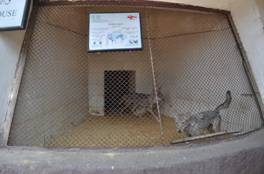
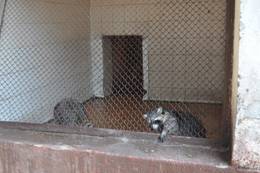
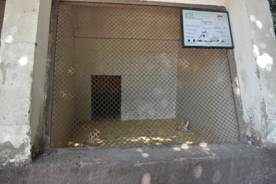
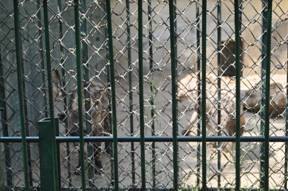
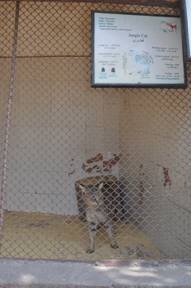
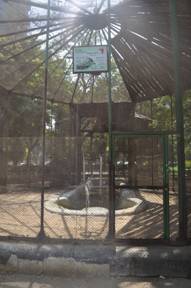
The Jungle cat could be transferred into the empty Egyptian
goose cage for example.
With switching some animals around, these problems could be
easily resolved. Birds, such as peacock and geese can be
moved out from exhibits too large for them into some of the hoof
stock exhibits such as the ponies,
hippos, etc.
As long as their feathers are clipped there should be no problems.
The carnivores could then be transferred into these closed
or half closed exhibits.
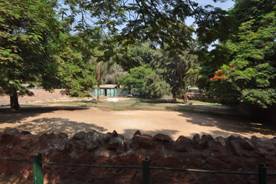
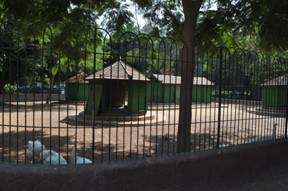
The beautiful pony exhibit could hold several bird and other
hoof stocks, while the peacock exhibits can be a new home
for hyenas or jackals, etc.
Bears
The bears are also in dire need of change. The cages are
generally empty with extremely small floor space and no
substrate of any kind. These animals will need to be moved out to
larger areas eventually. In the meantime, they will need to
be accessed inside 24 hours per day (with substrate provided
in the night houses) to increase space and the cage will
need to be used in its full capacity of 3 dimensions by
adding climbing structures all the way to the ceiling such as
large palm and other (edible) tree logs, wooden benches, ladders,
hammocks, etc. Tires should be hanging from chains and other
toys such as larger balls, plastic barrels, rotting smaller
logs, etc., can be added for enrichment. A general list of
bear enrichments is attached for your convenience.
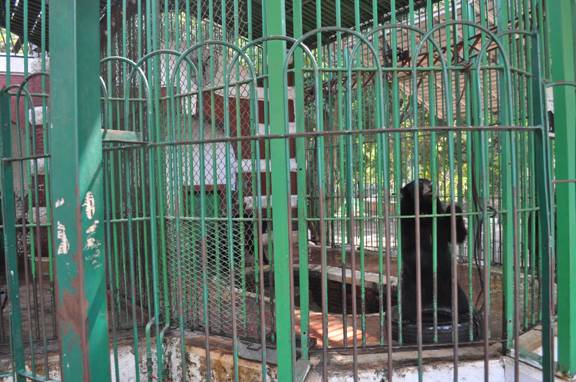
ALEXANDRIA ZOO
Chimpanzees
The same feeding and separating arrangements can be
applied for the 3 males as well. The animals should be kept
together at all times including feeding time unless there are some
difficulties. In that case, they can be separated for
feedings and/or sleeping. If the animals are fine at
night together, then they should be left together at all
times with access to both the inside and outside cages.
First, two animals can be put together, then the keepers
should wait until they settled
down and then let the third one in as well.
The animals should be locked inside only during the
wintertime and the side cage (Meshmesh’s old cage without
view) should not be used unless the door is open to the other
two cages at the same time as well.
Elephant
0.1 Indian elephant is quite old (close to 70) and not
in the best shape. The situation is the same, concrete, no
substrate, no foot work at all, no proper feeding, no browse
and the animal is chained most of the time for picture
taking. The nails need to be trimmed immediately
please. The management is encouraged to contact Heather Wright
Phoenix Zoo Elephant
Manger for further consultation on
foot work. 1 meter of sand
needs to be placed
both inside and outside of the
holding areas.
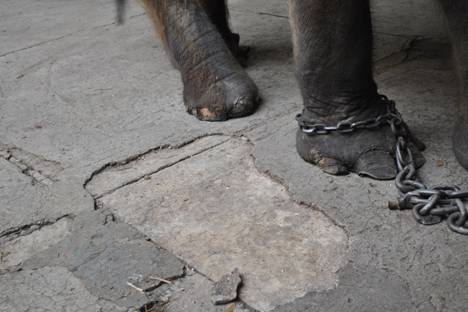
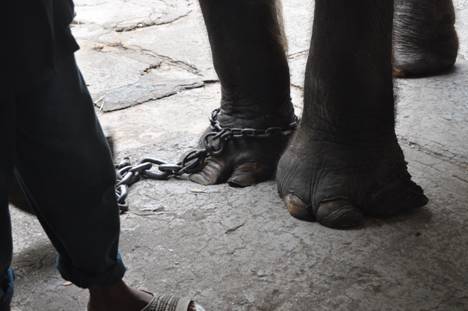
I could not go around the zoo due to time constraints, but
the same suggestions would apply to any cages, exhibits,
etc.
I would like to thank the Management at the Giza and
Alexandria Zoos for inviting me to visit your zoos and work
with your staff to improve animal welfare.
We
have made many improvements, especially in the
chimpanzees’ lives, while initiating basic husbandry
programs.
I would also like to express my deepest appreciation to Dr.
Osama Mahmoud Ahmed Selim and the GOVS, the Jane Goodall
Institute and the Phoenix Zoo for supporting me in my work
and allowing me the opportunity to be part of this
incredible journey.
And last, but not least, many special thanks to Dina Zulficar and
for her endless work to organize this trip and as liaison
between all institutions for all these years.
|


